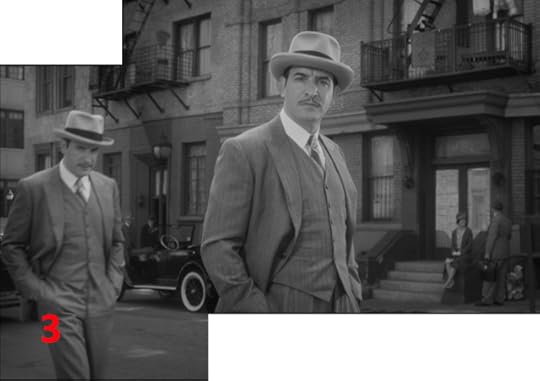John Bengtson's Blog, page 28
August 8, 2012
Charlie Chaplin, Ron Swanson, and Parks and Recreation
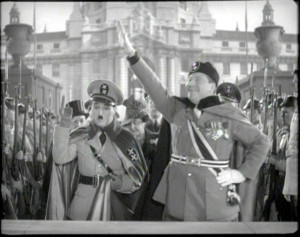
Charlie Chaplin and Jack Oakie in The Great Dictator
Location filming has been staged in Los Angeles now for well over a century. It should come as no surprise then that contemporary television shows share exterior settings that once appeared in classic films. In one prior post I explain how The Office TV show shares a connection to Harold Lloyd and film noir. In another recent post I show connections between the popular crime procedural Bones and Buster Keaton. Now its time to show the connection between Charlie Chaplin, and the popular mockumentary style sitcom Parks and Recreation. During Chaplin’s bold political satire The Great Dictator (1940), Charlie’s character Adenoid Hynkel stages an enormous rally to greet Dictator Benzino Napaloni (played by Jack Oakie). Although filmed inside a soundstage, the Pasadena City Hall appears as a backdrop during the scene.

Pasadena City Hall, in The Great Dictator (left) and in Parks and Recreation (right).
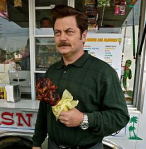
Nick Offerman as Ron Swanson
The same Pasadena City Hall stands in for the City Hall of Pawnee, Indiana, the fictional town portrayed in the Parks and Recreation television show. Given that Pawnee is supposed to be just an average town, the show rarely (never?) depicts the building’s massive baroque dome, but instead uses tight shots of the entrance arch, flanked by the words “CITY HALL,” giving the building a more modest sense of scale. One thing in the show that is not modest is popular character Ron Swanson’s mustache. The meat-eating Libertarian played by Nick Offerman sports a mustache three times larger than Chaplin’s.
Designed in 1925 by John Bakewell, Jr., and Arthur Brown, the Pasadena City Hall building is located at 100 N. Garfield Avenue at Union Street in Pasadena.
View Larger Map
All images from Chaplin films made from 1918 onwards, copyright © Roy Export Company Establishment. CHARLES CHAPLIN, CHAPLIN, and the LITTLE TRAMP, photographs from and the names of Mr. Chaplin’s films are trademarks and/or service marks of Bubbles Incorporated SA and/or Roy Export Company Establishment. Used with permission. Parks and Recreation (C) Universal Television.
Filed under: Charlie Chaplin Tagged: Chaplin Tour, Charlie Chaplin, Nick Offerman, Parks and Recreation, Pasadena City Hall, Ron Swanson, Silent Comedians, Silent Comedies, Silent Movie Locations, Silent Movies, The Great Dictator, then and now

August 4, 2012
Keaton’s Sherlock Jr. Hollywood Vault (with Harold Lloyd too)

The arrow points east down Hollywood Boulevard from a small park at La Brea towards a gas station on Sycamore (box) and the extant Johnny Grant Building (oval). The Garden Court Garage, now lost, stood to the left of the oval, across the street from the also lost Garden Court Apartments (1). The Mary Moll home (2) became the site of the Roosevelt Hotel. The lost Hotel Hollywood (3) stood at Hollywood and Highland. Baist’s Real Estate Surveys of Los Angeles 1921 – Plate 040. HistoricMapWorks.com
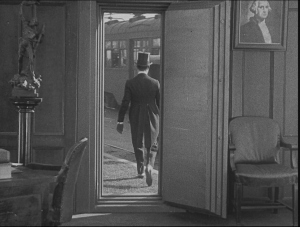
Sherlock Jr. steps out his door as a trolley passes by.
In his 1924 comedy Sherlock Jr., Buster Keaton portrays a daydreaming movie theater projectionist who fancies himself a great detective. During the movie’s lengthy dream sequence, Buster’s character, after falling asleep on the job, finds himself living wild adventures on the projected movie screen as Sherlock Jr., the world’s greatest detective. Here, Sherlock opens a massive wall safe in his mansion to reveal that it is actually his front door, leading out onto a busy street.

Looking east down Hollywood Boulevard, circa 1924, the Garden Court Apartments (1), the palm trees in front of the Hotel Hollywood (3), the palm trees at the Mary Moll home, future site to the Roosevelt Hotel (2), the corner of the extant Johnny Grant Building (oval), with a nine-arch facade, and the gas station billboard on the corner of Sycamore (box). Delmar Watson Photography Archive – The Watson Family Photography Archive.
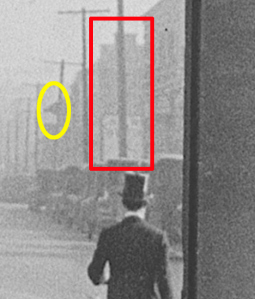 Keaton filmed this scene from a special set built on a small triangular park that is now called the Hollywood La Brea Gateway. The view looks east down Hollywood Boulevard from the park. The white billboard for the H. P. Rehbein Richfield gas station (red box above) on the corner of Sycamore appears above Buster’s hat (left). Across the street stood the Garden Court Apartments (1), a former Hollywood landmark where stars such as John Gilbert, Rudolph Valentino, Lillian Gish, and in later years Marilyn Monroe once lived. The property fell on hard times, and was shut down in 1980, and demolished in 1984.
Keaton filmed this scene from a special set built on a small triangular park that is now called the Hollywood La Brea Gateway. The view looks east down Hollywood Boulevard from the park. The white billboard for the H. P. Rehbein Richfield gas station (red box above) on the corner of Sycamore appears above Buster’s hat (left). Across the street stood the Garden Court Apartments (1), a former Hollywood landmark where stars such as John Gilbert, Rudolph Valentino, Lillian Gish, and in later years Marilyn Monroe once lived. The property fell on hard times, and was shut down in 1980, and demolished in 1984.

Click to enlarge. The gas station on the corner of Sycamore (box), the Garden Court Apartments (1), the extant Johnny Grant Building (oval), the Mary Moll home, future site of the Roosevelt Hotel (2), and the Hotel Hollywood (3). The Garden Court Garage, mentioned below, now lost, stands to the left of the oval. Delmar Watson Photography Archive – The Watson Family Photography Archive.
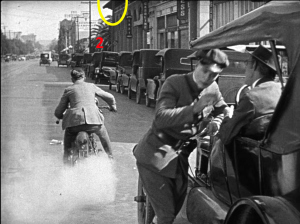
Girl Shy, looking east towards the Mary Moll home palm trees (2) and the extant Johnny Grant Building (oval).
Buster was not the only comedian to film on the west end of Hollywood Boulevard. These frames to the left and below come from Harold Lloyd’s Girl Shy (1924), Why Worry? (1923), and I Do (1921). The H.P. Rehbein Richfield gas station on the corner of Sycamore was later replaced by the multi-story Rehbein office building in 1925. Buster ran west past the Rehbein office building, while wearing a red devil suit, during the cattle stampede in his later comedy Go West (1925).

The same H. P. Rehbein Richfield gas station billboard appears in Girl Shy (left) and in Why Worry ? (right).

Two separate buildings, the extant Johnny Grant Building (left), with its extant corner (oval, appearing in all of the shots above), and the Garden Court Garage (right), now lost, shared a common nine-arch facade that stood along the south side of Hollywood Boulevard across the street from the Garden Court Apartments (1). The right image is from Harold Lloyd’s short I Do (1921). If you expand the other images above showing the corner of the Johnny Grant Building (oval), you can see nine arches in all, not merely five.

The arrow points east down Hollywood Boulevard, from the park on La Brea, where Buster built his vault set, towards the Rehbein Building (box, where the gas station stood on Sycamore), and the extant Johnny Grant Building (oval), adjacent to the Roosevelt Hotel (2), that now stands on the site of the former Mary Moll home. The Garden Court Apartments (1) and Hotel Hollywood (3) appear unchanged. Department of Special Collections, University of Southern California.
My special thanks to Antoinette Watson at the Watson Family Photographic Archive for the two vintage photos posted above.
Below, a modern Google Street View looking east towards the Hollywood La Brea Gateway, with Hollywood Boulevard stretching away from the camera in the background. The small foreground park, with the palm trees, is where Keaton built his vault set for Sherlock Jr. The white HIS shuttle bus is traveling the same path as the trolley during the movie.
View Larger Map
Sherlock Jr. licensed by Douris UK, Ltd. HAROLD LLOYD images and the names of Mr. Lloyd’s films are all trademarks and/or service marks of Harold Lloyd Entertainment Inc. Images and movie frame images reproduced courtesy of The Harold Lloyd Trust and Harold Lloyd Entertainment Inc.
Filed under: Buster Keaton, Sherlock Jr. Tagged: Buster Keaton, Garden Court Apartments, Girl Shy, Harold Lloyd, Hollywood, Hollywood Tour, Hotel Hollywood, I Do, Keaton Locations, Lloyd Locations, Roosevelt Hotel, Sherlock Jr., Silent Comedians, Silent Comedies, Silent Movie Locations, Silent Movies, then and now, Why Worry?

July 29, 2012
More Buster in Manhattan – The Cameraman, Part II
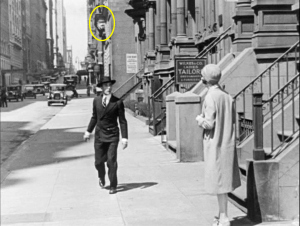
Click to enlarge. The cornice (oval) behind Buster Keaton belongs to the extant Coronet Apartments at the NE corner of 6th Avenue and W 58th Street (see oval below in modern view). The sign reads “Wilkes & Co Ladies Tailor,” that once stood at 37 W 58th Street.
Bob Egan’s fascinating website PopSpotsNYC.com explores visual archeology similar to my own. But instead of looking at silent-era comics, his site concerns places “where interesting events in the history of Pop Culture took place; like album cover shots, places where movies and tv shows were filmed, and sites on which paintings were based.” I wrote Bob to say hi, and in response was surprised to learn that an early Bob Dylan album cover was shot on Jacob Street just around the corner from where Buster Keaton shot Film (1964) in the shadow of the Brooklyn Bridge, as described in my post Buster Keaton’s Manhattan Project.
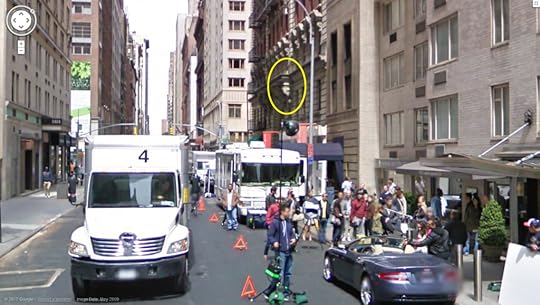
Nearly 85 years later, a modern film crew shooting in the same spot as Buster. (C) 2012 Google
While I’m based in California, Bob visits the New York Public Library frequently, so when he offered to help me look things up, I mentioned the above scene from Buster Keaton’s 1928 feature The Cameraman, where Buster takes Sally (played by Marceline Day) out for a stroll. Beside her apartment is a sign for Wilkes & Co. Ladies Tailor. Bob quickly wrote back that Wilkes was situated at 37 West 58th Street in Manhattan, half a block from the Plaza Hotel. Harold Lloyd stayed at the Plaza when filming Speedy (1928), so if Buster stayed there too, this setting would have been a particularly convenient location for Buster to shoot. While Marceline’s apartment is long gone, the cornice of the extant Coronet Apartments appears behind Buster’s head. More fun, the Google Street View of this setting shows a contemporary camera crew shooting a movie at the same spot where Buster had filmed nearly 85 years prior.

Click to enlarge. The urn-decorated third floor balcony of the back of the extant Steinway Building (box) appears behind Buster further west down W 58th Street, past 6th Avenue. The other buildings to the right in the vintage view all seem to remain standing. The oval marks the extant Coronet Apartment on the near corner of 6th Avenue. (C) 2012 Google.
On close examination, it appears that all of the buildings behind Buster in the far right of the frame, on the block of 58th Street due west of 6th Avenue, are also still standing.

The red arrow marks the point of view from Marceline’s apartment (small box) towards the Coronet. The purple arrows marks Buster’s path as he races in front of Bergdorf-Goodman, while hopping a low fence in front of the Pulitzer Memorial Fountain. The large red box on the right marks the now lost Cornelius Vanderbilt mansion, the future site to Bergdorf-Goodman. New York Public Library.
When I looked at this map Bob also sent me, I realized that Buster had filmed an immediately preceding scene on the same block. Buster’s date with Sally begins when she calls to say she is free to see him. The joke is that Buster drops the phone, and races so swiftly on foot to her apartment, that he arrives there before Sally realizes he is no longer on the phone. Buster begins his sprint running up 5th Avenue, as shown in my prior The Cameraman post. But just prior to arriving at her place, reader Andy Charity discovered that Buster ran past the recently opened Bergdorf-Goodman department store facing the Pulitzer Memorial Fountain. We can see from the above map that Marceline’s apartment (left box) stood half a block from where Buster ran across the park (purple arrow). The rest of this post is an update of my story about Harold, Buster, Bergdorf-Goodman that ran last year.

Looking north up 5th Avenue towards the corner of W 57th, and the Bergdorf-Goodman construction site at the upper left. The trees at back are part of the Pulitzer Fountain Park
Towards the end of Harold Lloyd’s manic taxi-ride driving Babe Ruth up 5th Avenue in New York during Speedy (released in 1928, but filmed during the summer of 1927), they approach W 57th Street, and the final of five traffic towers that once helped to regulate traffic flow along this major thoroughfare. As I explain in Silent Visions, you can see at this corner the ongoing construction of the Bergdorf-Goodman store, built on the site of the former Cornelius Vanderbilt mansion. A stock footage shot of the mansion appears briefly during Buster Keaton’s debut feature film The Saphead (1920) (see further below).

The W 58th Street facade of Bergdorf-Goodman, facing the Pulitzer Fountain Park. The oval and box mark matching details in the Keaton panorama below. Microsoft Streetside (C) 2010 Microsoft Corporation

Scene from The Cameraman. The full panorama as Buster runs along W 58th Street from 5th Avenue. He skips over a low wire fence that was part of the Pulitzer Fountain Park.
As shown here, eagle-eyed reader Andy Charity spotted that Buster Keaton ran west along W 58th Street from 5th Avenue, along the north face of the newly-opened Bergdorf- Goodman store, hopping over a short wire fence that was part of the landscaping for the Pulitzer Memorial Fountain across the street from the store. So here, for once, the geographic portrayal of New York was quite accurate. Coming west from 5th Avenue, Buster would have to pass Bergdorf-Goodman to reach Sally’s apartment further down the same street.

Both views show the SW corner of 5th and W 58th. The Bergdorf-Goodman store was built on the site of the Cornelius Vanderbilt mansion, shown as it appears in The Saphead (1920) to the right. The arrow marks the same relative spot, while the corner of the Pulitzer Fountain Park appears in the lower right corner.
Buster most likely did not realize as he ran past the SW corner of 5th and W 58th that the same SW corner appeared in his prior feature film set in New York. But now we know what Buster knew, that two scenes from his date with Marceline were filmed on the same block, and likely the same day.
The Cameraman images (C) 1928 Turner Entertainment Co.
HAROLD LLOYD images and the names of Mr. Lloyd’s films are all trademarks and/or service marks of Harold Lloyd Entertainment Inc. Images and movie frame images reproduced courtesy of The Harold Lloyd Trust and Harold Lloyd Entertainment Inc.
View Larger Map
Filed under: Buster Keaton, Harold Lloyd, Manhattan, Speedy, The Cameraman Tagged: Bergdorf Goodman, Buster Keaton, Harold Lloyd, Manhattan, New York, Silent Comedians, Silent Comedies, Silent Movie Locations, Silent Movies, The Cameraman, then and now

July 18, 2012
The Artist Locations Part 8 – the Paramount Backlot

Looking north at the Paramount Studios backlot. The Hollywood Forever Cemetery appears along the top edge. (C) 2012 Microsoft Corporation, Pictometry Bird’s Eye (C) 2012 Pictometry International Corp.
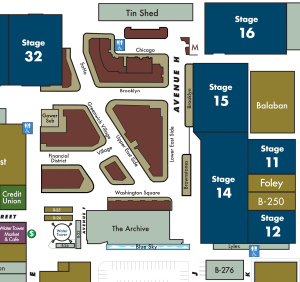
Click to enlarge. The Paramount Studios backlot.
My first post about The Artist filming locations shows that the three different movie theater exteriors appearing in the movie were all filmed at the Warner Bros. backlot. As shown here, apparently all of the other exterior city scenes from The Artist were filmed at the small New York City backlot at Paramount Studios. This post identifies eight different backlot settings, keyed to the map to the left.
My very special thanks go to J. Eric Lynxwiler for allowing me to post his wonderful photos of the Paramount Studios backlot. His Flickr Photostream, jericl cat’s photostream, which includes, in part, dozens of beautiful photos of vintage theaters, vintage matchbook covers, and vintage neon signs, may be accessed HERE.
 We begin with Scene (1), above, as character George Valentin strolls with Uggie the Dog north along the Lower East Side set towards the NW corner of the Brooklyn set.
We begin with Scene (1), above, as character George Valentin strolls with Uggie the Dog north along the Lower East Side set towards the NW corner of the Brooklyn set.
Scene (2) shows George crossing the Brooklyn 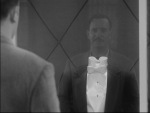 street, walking north towards a corner men’s shop. Once there, George gazes into the window, and sees his forlorn reflection align with a tuxedo on display, reminding him of happier days when he was a major silent film star.
street, walking north towards a corner men’s shop. Once there, George gazes into the window, and sees his forlorn reflection align with a tuxedo on display, reminding him of happier days when he was a major silent film star.
Below, Scene (3), still-prosperous George stops to inspect a banner promoting Peppy Miller’s new talking picture, and realizes it will premiere on the same day as his self-financed silent feature Tears of Love. The movie’s failure triggers George’s spiral of despair. This view looks south-east, at the opposite side of the Brooklyn street set, across from the men’s store (Scene (2)) side of the street.

The wall at the far left appears in Scene (6). (C) Matt Augustine – http://www.flickr.com/photos/mattapic...
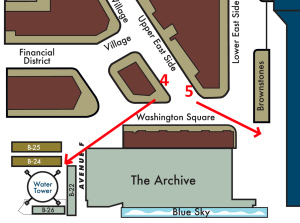 The next two scenes (4) and (5), were filmed as shown on the map to the left. During Scene (4) below, filmed looking south-west towards Washington Square, and the studio water tower (out of view), George turns the corner going north onto the Upper East Side street.
The next two scenes (4) and (5), were filmed as shown on the map to the left. During Scene (4) below, filmed looking south-west towards Washington Square, and the studio water tower (out of view), George turns the corner going north onto the Upper East Side street.
During Scene (5), filmed looking to the southeast, the gap between the Washington Square set, and the Brownstone set (right arrow), was covered with a green screen, and filled with a matte image of the Lonely Star Theater (see below).
Scene (4) above, a view looking south at the Washington Square set – the Warner Bros. water tower appears in the color view.
During Scene (5) above, looking south down the Upper East Side street towards Washington Square, George leaves the auction house after all of his possessions are liquidated. Unbeknownst to him, Peppy Miller’s servant purchased George’s possessions upon her instructions. Above, the servant leaves the auction house and crosses the street to report to Peppy.

This comparison view shows George crossing the gap between the Upper East Side set and the Washington Square set. The Lonely Star Theater (oval), “standing” where Stage 14 is located (red box), was a matte image created with the help of a green screen covering up the stage and filling the gap between the sets.
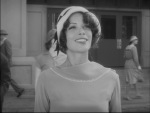 During Scene (6) Peppy arrives in Hollywood by bus (left), brimming with confidence following her unexpected publicity in the local newspapers. The setting for the bus arrival (see map and photo below), was filmed looking south along the face of the Brooklyn set running along what is called Avenue H.
During Scene (6) Peppy arrives in Hollywood by bus (left), brimming with confidence following her unexpected publicity in the local newspapers. The setting for the bus arrival (see map and photo below), was filmed looking south along the face of the Brooklyn set running along what is called Avenue H.
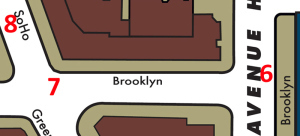 At the climax of the film, Peppy races her car to George’s apartment, hoping to arrive in time to avert a disaster. Two of my prior posts Number One and Number Seven show some of the true exterior locations appearing during Peppy’s frantic drive.
At the climax of the film, Peppy races her car to George’s apartment, hoping to arrive in time to avert a disaster. Two of my prior posts Number One and Number Seven show some of the true exterior locations appearing during Peppy’s frantic drive.
But other race scenes were filmed on the Paramount backlot. Scene (7) below shows Peppy driving from south to east around the corner of SoHo onto Brooklyn.

Peppy turns the corner from SoHo onto Brooklyn. The tall buildings at the far left are a matte image. The yellow oval marks the subway entrance lamps appearing in Scene (8) below. The red box marks the men’s store set from Scene (2).

Scene (7) – the yellow oval marks the subway entrance lamps appearing in Scene (8) below. The red box marks the men’s store set from Scene (2).
During Scene (8) below, Peppy races around the same backlot corner as Scene (7), only this time the view looks south instead of north.
The yellow ovals above mark the same subway entrance lamps appearing during Scene (7). The tall buildings in the background are another matte image, covering up the Washington Square set that appears at the far background in the color image.
The original Paramount New York backlot was destroyed by fire in 1983, and fully rebuilt in 1992. The New York set has appeared in hundreds of movie and television productions, including, by random example, the Coen brothers 2001 film noir feature The Man Who Wasn’t There.
The Artist (C) La Petite Reine, The Weinstein Company. The Paramount Studios backlot map (C) 2012 Paramount Studios, may be accessed HERE.
Below, an aerial view north of the Paramount Studios backlot, with the Brooklyn set running left-right across the center. You can expand the image, and zoom in and out, to get a better sense of this setting.
View Larger Map
Filed under: The Artist, Uncategorized Tagged: Hollywood Tour, Paramount Studios, Paramount Studios Backlot, Paramount Studios New York set, The Artist, the artist filming locations, The Artist locations

July 7, 2012
Buster Keaton’s The Cameraman
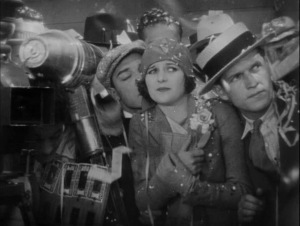
Buster Keaton and Marceline Day
The 2012 San Francisco Silent Film Festival concludes this year on Sunday, July 15, with a 7:30 pm screening of Buster Keaton’s 1928 comedy triumph The Cameraman. I’ll be signing my three books in the upstairs lobby beginning at 6:30 (one of the many author events sponsored by Books Inc.), so stop by and say hello.
Set in New York, but filmed mostly in Hollywood, The Cameraman was Keaton’s last silent feature production, and his first film for his new studio, M-G-M. Buster plays a tintype photographer, selling portraits on the sidewalk, who longs to become a newsreel cameraman in order to impress Sally (played by Marceline Day), a receptionist for the Hearst Newsreel Company. While I cover the New York and Hollywood locations more extensively in my Keaton book Silent Echoes, here are a few fun discoveries. (See my more recent post for a new Manhattan discovery HERE).

Early in the film, Buster leaps aboard a moving fire truck at the iconic intersection of Hollywood and Vine, with the stately Taft Building standing in the background.
View Larger Map
This circa 1934 aerial view of Hollywood (below) shows the path (arrow) of Keaton’s fire truck at Hollywood and Vine (1), and later its path as it travels north up Cahuenga towards Hollywood Boulevard (2), before turning left into the former Hollywood fire station (4). The parking lot across from the fire station (3) is where Buster stows his pet cow Brown Eyes during his feature comedy Go West (1925), and the alley up the street (5) is where a passing car whisks Buster away one-handed during Cops (1922).

Click to enlarge. HollywoodPhotographs.com

(1) Hollywood and Vine; (2) up Cahuenga; (3) the Go West parking lot; (4) the fire station interior; (5) the Cops alleyway.
You can see more about early filming on Cahuenga Boulevard in Hollywood on my prior post Chaplin – Keaton – Lloyd – One Block in Silent-Era Hollywood.
Jumping to New York, when Sally calls Buster to tell him her plans have changed, and she is free to see him, Buster dashes up 5th Avenue from W 55th Street, and arrives at her apartment before she can hang up the phone. Later, Buster and Sally stroll along the same block.

During one of the few scenes filmed on location in New York, Buster races north up 5th Avenue from the corner of W 55th Street. To the far right stands the 5th Avenue Presbyterian Church. The spires in the center right background, my original clue to identifying this scene, belong to St. Patrick’s Cathedral, the 11th largest church in the world. In the modern view below the spires are blocked by glass skyscrapers.
View Larger Map
You can see more of Buster Keaton filming in New York in my prior post, Harold – Buster – and Bergdorf Goodman – NYC Then and Now.
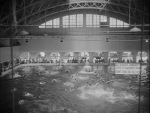
The Venice Plunge interior, as it appears during the film.
Another notable location appearing in The Cameraman is the Venice Plunge (now lost), the large indoor swimming pool located beside the former Abbot Kinney Pier, where Buster and Sally go on a date. Charlie Chaplin filmed beside the Venice Plunge in 1915 for his short comedy By The Sea.

The front of the Venice Plunge. Security Pacific National Bank Photograph Collection/Los Angeles Public Library
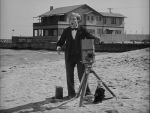
Buster beside the extant home at 2234 Channel Road in Newport Beach.
The conclusion of The Cameraman was filmed in Newport Beach in Orange County. The extant Newport Beach Pavilion appears in one early shot. The boat race was staged near the south end of Newport Bay. The oval in this aerial view below shows where the speed boat runs in a circle. The blue dot below show where Buster captures the speed boat on camera, standing before the extant home at 2234 Channel Road, appearing behind Buster during the scenes (at left).

Buster stood near the blue dot above, filming across the channel towards Bayside Drive, as the speed boat races in a circle (oval above). (C) 2012 Microsoft Corporation, Pictometry Bird’s Eye (c) 2012 Pictometry International Corp.
The Cameraman images (C) 1928 Turner Entertainment Co.
Filed under: Buster Keaton, Manhattan, The Cameraman Tagged: Buster Keaton, Manhattan, Silent Comedies, Silent Movie Locations, Silent Movies, The Cameraman, then and now, Venice







